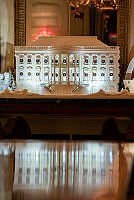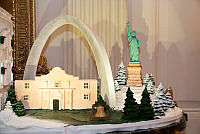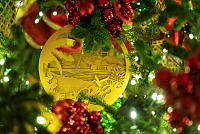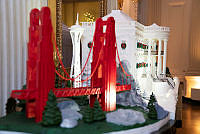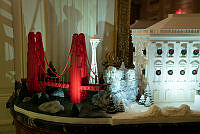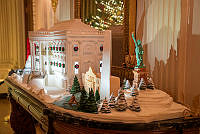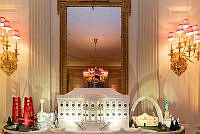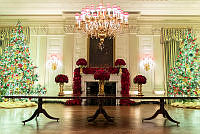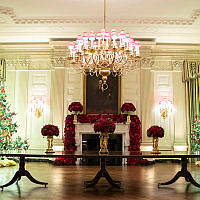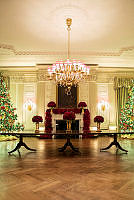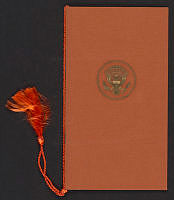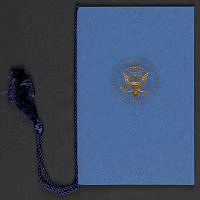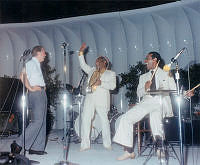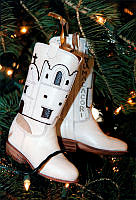Rubenstein Center Scholarship
The Nation's Guest
General Lafayette's 1824-1825 Tour of the United States

This is a portrait of the Marquis de Lafayette. The framed piece hangs in the Entrance Hall of Blair House and is the first work of art guests observe upon entering the house. This is a fitting location for his painting since Lafayette was the nation’s guest and Blair House serves as the President’s guesthouse for today’s visiting heads of state.
On September 7, 1825, a tearful Marquis de Lafayette embraced President John Quincy Adams after delivering a farewell speech at the entrance to the White House. The ceremony signified the end of the famed Frenchman’s triumphant return to the United States from 1824 to 1825. This visit inspired patriotic celebrations and expressions across a young country during the waning days of the “Era of Good Feelings.”1 Originally intended as a four-month tour, the general’s visit soon stretched into a thirteen-month journey to all twenty-four states. He was received with great enthusiasm throughout the country as cities and towns honored the Revolutionary War hero with parades, monuments, songs, dances, and ceremonies. Not to be outdone, the White House hosted meetings, dinners, and celebrations for Lafayette throughout his tour. When Lafayette departed the White House for the final time, he had undoubtedly left a profound impression on the American people.
In February 1824, Lafayette received a letter from President James Monroe on behalf of Congress following a joint resolution, inviting him to visit the United States. The letter expressed the “sincere attachment of the whole Nation...whose ardent desire is once more to see you amongst them.”2 Lafayette was excited to return to America and departed from the French port of Le Havre on July 13, 1824. He was accompanied by his son, George Washington Motier de Lafayette, as well as his valet and secretary Auguste Levasseur.3 Throughout the journey, Levasseur documented Lafayette’s travels while recording fascinating observations of life in the United States.
On August 14, 1824 Lafayette arrived in New York Harbor as tens of thousands turned out to greet him.4 After his enthusiastic reception in New York, Lafayette made his way north to Boston and then on to Philadelphia. Receptions, parades, and celebrations greeted him in each of these cities. He finally reached Washington, D.C. for his first visit on October 12th. Lafayette was escorted from Baltimore by a volunteer cavalry troop led by a former Maryland governor, Samuel Sprigg. Artillery salutes marked his entrance and crowds soon pressed in, following the procession to the President’s House.5

This Empire period music stand was made around 1830, during Andrew Jackson's presidency. The sheet music that appears on the stand is entitled "Lafayette's March," a song composed to commemorate the French military leader's 1824-1825 tour of the United States.
White House Historical AssociationAfter a stop at the United States Capitol Building, Lafayette’s carriage passed through the White House gates and arrived at the Executive Mansion.6 The general and his company were received by the Marshal of the District of Columbia who escorted them into the White House to meet with the president. They entered the Oval Drawing Room, today’s Blue Room, where Monroe was seated on a chair, “not differing in form or elevation from the rest,” surrounded by a semi-circle of various government officials.7 At his right sat the secretaries of state and treasury, while the secretaries of war and navy sat to his left.8 To the astonishment of Lafayette’s secretary, they all wore plain blue clothing without elaborate embroidery or decoration. Levasseur was also surprised by the simplicity of the Executive Mansion itself, describing it as “very simple, but in good taste.” 9
As Lafayette entered the room, the assembled officials rose and President Monroe advanced to greet and introduce him to the assembled guests. After this introduction, Monroe expressed his regret that Lafayette would not be staying at the White House, explaining, “The people of Washington claim you; they say that as the Nation’s Guest, none but the nation has the right to lodge you.”10 After conversing with the group, Lafayette took his leave and departed the White House to attend a public banquet.
The next morning Lafayette returned for breakfast with the president and in the evening he and his company dined with the president, his wife Elizabeth and daughters Eliza and Maria, and approximately sixty invited guests including cabinet members, Supreme Court justices, and military officers.11 Lafayette occupied a seat of honor to the right of President Monroe as the dinner commenced. At the conclusion of the meal he retired promptly to ensure he was well rested for his busy itinerary.

This bust of the Marquis de Lafayette was created at the National Porcelain Factory of Sèvres after the work of sculptor Jean-Antoine Houdon. Houdon was renowned for his busts of famous politicians of the time. This bust is made of unglazed porcelain and rests atop a long, dark, marble column. The factory was established in 1738 and became the royal factory in 1759. It remains closely tied to the French state today and is run by the Ministry of Culture.
White House CollectionLafayette departed Washington, D.C. the following morning and spent the next month travelling throughout Virginia. He visited numerous sites and people, including George Washington’s family at Mount Vernon, the battlefields of Yorktown, and his old friends Thomas Jefferson and James Madison. In November, he spent ten days with Jefferson and four days with Madison, visiting their homes and sharing hours of conversation.12 In December, Lafayette returned to Washington, D.C., primarily staying in and around the city for the next several months as winter weather made travel difficult.
During his second stay in the capital city, Lafayette witnessed the contentious presidential election of 1824 between John Quincy Adams, Andrew Jackson, Henry Clay, and William Crawford. The election was eventually decided in favor of Adams by the House of Representatives on February 9, 1825.13 That same evening, Lafayette attended a White House dinner but all eyes were on Adams, Clay, and Jackson, who were also invited. Levasseur described the moment the two embattled competitors, Andrew Jackson and president-elect John Quincy Adams, met each other amidst the crowded party. Adams and Jackson saw each other, approached and then shook hands as Levasseur noted, “The congratulations offered by General Jackson were open and sincere; Mr. Adams seemed deeply moved…” Levasseur thought the moment spoke volumes about the strength of the young democracy.14
Soon after the post-election White House dinner, General Lafayette departed from Washington, D.C. to continue on his national tour. This time he traveled for many months. He attended celebrations, laid cornerstones, and stayed for a second visit with former president John Adams. Lafayette arrived returned to Washington, D.C. later that summer to visit the White House and its newest resident, John Quincy Adams. President Adams brought Lafayette to Virginia for a visit with James Monroe. After the visit, Adams returned to Washington while Lafayette continued his travels in Virginia which culminated in a final visit with former presidents Jefferson, Madison and Monroe. A deep sadness hung in the air of Lafayette’s departure from this gathering as they knew this would likely be the last time they would be in each other’s company.15

This statue honors Revolutionary War hero Marquis de Lafayette, whom the park is also named after. The statue is on the southeast corner of Lafayette Park.
White House Historical AssociationAfter these solemn farewells, it was finally time for Lafayette and his companions to begin their return voyage to France. However, President Adams could not allow the general to leave without one last celebration in his honor. To celebrate Lafayette’s September 6 birthday, Adams hosted a dinner at the White House to commemorate the occasion. Although intended as a grand event, Lafayette’s impending departure gave it a more somber tone. During the dinner President Adams offered a short toast: “To the 22nd of February and 6th of September, birthdays of Washington and Lafayette.”16 In response, Lafayette expressed his sincere thanks to President Adams, toasting, “To the fourth of July, the birthday of liberty in both hemispheres.”17
At long last, the day of departure had arrived after a thirteen-month journey rekindling old friendships, celebrating past triumphs, and inspiring renewed patriotism in the hearts of the American people. The “nation’s guest,” was finally ready to return home. On the morning of September 7, 1825, banks closed and business was suspended as the people of Washington gathered around the White House in anticipation of Lafayette’s departure.18 A group formed in the White House Entrance Hall, arranging themselves in a circle. President Adams stepped forward and the doors were opened so that the public could listen to his address. His moving tribute to Lafayette expressed his gratitude and joy in his visit stating, “it were scarcely an exaggeration to say, that it has been, to the people of the Union, a year of uninterrupted festivity and enjoyment, inspired by your presence.”19 Following President Adams’ speech, Lafayette gave an emotional response which concluded, “God bless the American people, each of their states, and the federal government. Accept this patriotic farewell of an overflowing heart; such will be its last throb when it ceases to beat.”20
Lafayette embraced the president and went back inside to regain his composure. He returned to hug President Adams once more uttering, “God Bless You!” and then officially departed the White House.21 Lafayette entered a carriage with the secretaries of state, treasury, and navy and proceeded along a crowded route to the Potomac River. Here the Frenchman and his party boarded the steamboat Mount Vernon which transported them to The Brandywine, a ship named in honor of the 1777 battle in which Lafayette was wounded. Lafayette spent the night aboard the ship and the next morning he ended his American tour by starting his journey back to France.22
Lafayette’s visit certainly left its mark on the American people. Numerous buildings, streets, and towns throughout the country were named in his honor. The President’s Park was no exception. At some point following Lafayette’s visit, the public square across from the White House was named Lafayette Square in his honor.23 In 1891 a statue was erected in the park honoring the Marquis de Lafayette. Many foreign dignitaries have passed by this statue on their way to the White House, but it has particular significance for the French and has been honored accordingly. In 1951, French President Vincent Auriol visited the United States. In honor of this arrival, Lafayette’s statue was illuminated and a wreath was placed at its base as the French president traced a similar parade route to the one taken by Marquis de Lafayette in 1824.24





